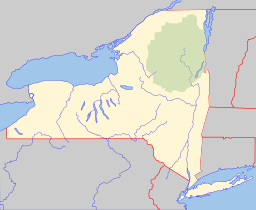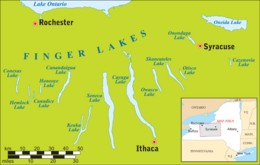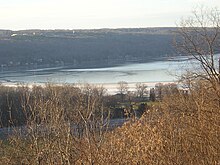| Cayuga Lake | |
|---|---|
 Cayuga Lake as viewed in the late afternoon from Cornell University in the early 2000s. Cayuga Lake as viewed in the late afternoon from Cornell University in the early 2000s. | |
  | |
| Location | Cayuga / Seneca / Tompkins counties, New York, U.S. |
| Group | Finger Lakes |
| Coordinates | 42°41′17″N 76°42′8″W / 42.68806°N 76.70222°W / 42.68806; -76.70222 |
| Lake type | Ground moraine |
| Primary inflows | Fall Creek, Cayuga Inlet, Salmon Creek, Taughannock Creek, Six Mile Creek |
| Primary outflows | Seneca River |
| Catchment area | 2,033 km (785 sq mi) |
| Basin countries | United States |
| Max. length | 61.4 km (38.2 mi) |
| Max. width | 3.5 mi (5.6 km) |
| Surface area | 172 km (66 sq mi) |
| Average depth | 54.5 m (179 ft) |
| Max. depth | 133 m (436 ft) |
| Water volume | 9.4 km (2.3 cu mi) |
| Residence time | 18.2 years |
| Shore length | 153.4 km (95.3 mi) |
| Surface elevation | 381.9 ft (116.4 m) |
| Islands | 2 (Frontenac Island and Canoga Island) |
| Settlements | see article |
| References | |
| Shore length is not a well-defined measure. | |
Cayuga Lake (/kəˈjuːɡə/, /keɪˈjuːɡə/ or /kaɪˈjuːɡə/) is the longest of central New York's glacial Finger Lakes, and is the second largest in surface area (marginally smaller than Seneca Lake) and second largest in volume. It is just under 39 miles (63 km) long. Its average width is 1.7 miles (2.8 km), and it is 3.5 mi wide (5.6 km) at its widest point, near Aurora. It is approximately 435 ft deep (133 m) at its deepest point, and has over 95 miles (153 km) of shoreline.
The lake is named after the indigenous Cayuga people.
Location
The city of Ithaca, site of Ithaca College and Cornell University, is located at the southern end of Cayuga Lake.
On the Northern shore rests Seneca Falls, the historical Birthplace of Women’s Rights and the Seneca Falls Convention, and what is widely accepted as the real Bedford Falls from the Frank Capra movie It's A Wonderful Life. The Town Seneca Falls, comprises 25.3 square miles and is nestled in the Finger Lakes region located at the northern tip of Cayuga Lake, and is home to approximately 8,650 residents. It is one of ten townships in Seneca County and its largest community.
Villages and settlements along the east shore of Cayuga Lake include Myers, King Ferry, Aurora, Levanna, Union Springs, and Cayuga. Settlements along the west shore of the lake include Sheldrake, Poplar Beach, and Canoga.
The lake has two small islands. One is near Union Springs, called Frontenac Island (northeast); this island is not inhabited. The other island, Canoga Island (northwest), is located near the town of Canoga. This island has several camps and is inhabited during the summer months. The only other island in any of the Finger Lakes is Skenoh Island in Canandaigua Lake.
Geographical characteristics

The lake depth, with steep east and west sides and shallow north and south ends, is typical of the Finger Lakes, as they were carved by glaciers during the last ice age.
The water level is regulated by the Mud Lock at the north end of the lake. It is connected to Lake Ontario by the Erie Canal and Seneca Lake by the Seneca River. The lake is drawn down as winter approaches, to minimize ice damage and to maximize its capacity to store heavy spring runoff.
The north end is dominated by shallow mudflats. An important stopover for migratory birds, the mudflats and marsh are the location of the Montezuma National Wildlife Refuge. The southern end is also shallow and often freezes during the winter.
Human impact

Cayuga Lake is very popular among recreational boaters. The Allan H. Treman State Marine Park, with a large state marina and boat launch, is located at the southern end of the lake in Ithaca. There are two yacht clubs on the western shore: Ithaca Yacht Club, a few miles north of Ithaca, and Red Jacket Yacht Club, just south of Canoga. There are several other marinas and boat launches, scattered along the lake shore.
Cayuga Lake is the source of drinking water for several communities, including Lansing, near the southern end of the lake along the east side, which draws water through the Bolton Point Water System. There are also several lake source cooling systems that are in operation on the lake, whereby cooler water is pumped from the depths of the lake, warmed, and circulated in a closed system back to the surface. One of these systems, which is operated by Cornell University and began operation in 2000, was controversial during the planning and building stages, due to its potential for having a negative environmental impact. However, all of the environmental impact reports and scientific studies have shown that the Cornell lake source cooling system has not yet had, and will not likely have any measurably significant environmental impact. Furthermore, Cornell's system pumps significantly less warm water back into the lake than others further north, which have been operating for decades, including the coal-fired power plant on the eastern shore.

The AES Coal Power plant was shut down in August 2019, and there are plans to convert it into a data center in the near future. The plant used to use Cayuga Lake as a cooling source. In the late 1960s, citizens successfully opposed the construction of an 830-MW nuclear power plant on the shore of Cayuga Lake.
Rod Serling named his production company Cayuga Productions, during the years of his TV series, The Twilight Zone. Serling and his family had a summer home at Cayuga Lake.
Fishing
The fish population is managed and substantial sport fishing is practiced, with anglers targeting smelt, lake trout and smallmouth bass. Fish species present in the lake include lake trout, landlocked salmon, brown trout, rainbow trout, smallmouth bass, smelt, alewife, atlantic salmon, black crappie, bluegill, pickerel, largemouth bass, northern pike, pumpkinseed sunfish, rock bass, and yellow perch. The round goby has been an invasive species in the lake since the 1990s. There are state owned hard surface ramps in Cayuga–Seneca Canal, Lock #1 (Mud Lock), Long Point State Park, Cayuga Lake State Park, Deans Cove Boat Launch, Taughannock Falls State Park, and Allan H. Treman State Marine Park.
Tributaries
The major inflows to the lake are: Fall Creek, Cayuga Inlet, Salmon Creek, Taughannock Creek, and Six Mile Creek; while the lake outflows into the Seneca River and other tributaries. Ungaged tributaries that inflow to the lake include:
- Barnum Creek
- Bergen Creek
- Big Hollow Creek
- Bloomer Creek
- Canoga Creek
- Dean Creek
- Demont Creek
- Glen Creek
- Glenwood Creek
- Great Gully Brook
- Groves Creek
- Gulf Creek
- Indian Creek
- Little Creek
- Lively Run
- Mack Creek
- Minnegar Brook
- Morrow Creek
- Paines Creek
- Red Creek
- Schuyler Creek
- Sheldrake Creek
- Trumansburg Creek
- Williams Brook
- Willow Creek
- Yawger Creek
Folklore

The lake is the subject of local folklore.
An Ithaca Journal article of 5 January 1897, reported that a sea serpent, nicknamed "Old Greeny," had been sighted in Cayuga Lake annually for 69 years. A sighting in that month described the animal, 200 feet (61 m) from shore, as "large and its body long", although a "tramp" suggested it was a muskrat. In 1929, two creatures, about 12 to 15 feet (3.7 to 4.6 m) in length, were reportedly spotted along the eastern shore of the lake. Further sightings were reported in 1974 and 1979.
Cornell's alma mater makes reference to its position "Far Above Cayuga's Waters", while that of Ithaca College references "Cayuga's shore".
A tradition at Wells College in Aurora, NY, held that if the lake completely freezes over, classes are canceled, though for only one day. According to Wells College records, this happened eight times, in "1875, 1912, 1918, 1934, 1948, 1962, 1979 and 2015."
Cayuga Lake, like nearby Seneca Lake, is also the site of a phenomenon known as the Guns of the Seneca, mysterious cannon-like booms heard in the surrounding area. Many of these booms may be attributable to bird-scarers, automated cannon-like devices used by farmers to scare birds away from the many vineyards, orchards and crops. There is, however, no proof of this.
Wine
See also: Cayuga Lake AVACayuga Lake is included in the American Viticultural Area with which it shares its name. Established in 1988, the AVA now boasts over a dozen wineries, four distilleries, a cidery, and a meadery.
See also
References
- ^ "Appendix B. Cayuga Lake Model (CLM-2D) Setup and Calibration for Cayuga Lake" (PDF). New York State Department of Environmental Conservation. 2015. Archived (PDF) from the original on 24 June 2021. Retrieved 20 June 2021.
- ^ "Cayuga Lake". International Lake Environment Committee Foundation. Retrieved 20 June 2021.
- "Cayuga Lake". Geographic Names Information System. United States Geological Survey, United States Department of the Interior. 23 January 1980.
- Baca, Keith A. (2007). Native American Place Names in Mississippi. University Press of Mississippi. p. 20. ISBN 978-1-60473-483-6.
- "The role of experts in a nuclear siting controversy". eric.ed.gov.
- Balogh, Brian (1991). Chain Reaction: Expert debate and public participation in American commercial nuclear power 1945–1975 (ills. rev. ed.). Cambridge University Press. pp. 262–264. ISBN 978-052145736-1 – via Google books.
- Rudig, Wolfgang (1990). Anti-nuclear Movements: A world survey of opposition to nuclear energy. Longman. pp. 126–127.
- Falk, Jim (1982). Global Fission: The battle over nuclear power. Oxford University Press. p. 94.
- "Q & A (FAQ)". Rod Serling (rodserling.com). 22 February 2009. Archived from the original on 1 June 2009. Retrieved 20 June 2021.
- Corkum, L.D.; Sapota, M.R.; Skora, K.E. (2004). "The round goby, Neogobius melanostomus, a fish invader on both sides of the Atlantic Ocean". Biological Invasions. 6 (2): 173. doi:10.1023/B:BINV.0000022136.43502.db. S2CID 24355546.
- Western Adirondacks New York. Fishing map guide. Sportsman's Connection. 2011. ISBN 978-1-885010-63-6. OCLC 986498446.
Includes lakes & streams for the following counties: Allegany, Broome, Cattaraugus, Cayuga, Chautauqua, Chemung, Cortland, Erie, Livingston, Madison, Monroe, Niagara, Onondaga, Ontario, Orleans, Oswego, Schuyler, Seneca, Steuben, Tioga, Tompkins, Wayne, Wyoming, and Yates.
- ^ "Green monsters and murderers: Lore and legends of Cayuga Lake". The Ithaca Journal. 22 August 2014. pp. 22–24. Retrieved 18 May 2020.
- ^ Githler, Charley (26 July 2018). "Here there be monsters: Diving into the legacy of the beasts of the Finger Lakes". Ithaca.com. Retrieved 18 May 2020.
- ^ Sachse, Gretchenb (28 December 1996). "Cayuga's monster thrilled New Year's revelers". The Ithaca Journal. p. 2A. Retrieved 18 May 2020.
- "Wells College Student Traditions". Wells College (wells.edu) (official website). The Student Life Office. Aurora, NY: Wells College. 2007. Archived from the original on 25 January 2008. Retrieved 16 January 2008.
- "Wells College records". p. 570 – via alumni.wells.edu.
- "What are the lake drums?". cayugafisher.net. Retrieved 12 April 2017.
- "Seneca Lake, home of the lake farts". New York Traveler (newyorktraveler.net). Archived from the original on 11 December 2008. Retrieved 12 April 2017.
- Code of Federal Regulations. "§ 9.127 Cayuga Lake." Archived 2008-01-19 at the Wayback Machine Title 27: Alcohol, Tobacco and Firearms; Part 9 — American Viticultural Areas; Subpart C — Approved American Viticultural Areas. Retrieved Feb. 6, 2008.
- "Wineries". Cayuga Lake Wine Trail. Retrieved 26 June 2011.
External links
- World Lakes Database - Cayuga Lake
- Cayuga Lake Watershed Network
- The Cayuga Lake Defense Fund
- Cornell's Lake Source Cooling FAQ
- Cornell's environmental impact statement for Lake Source Cooling
| New York's Finger Lakes | |
|---|---|
- Finger Lakes
- Anti-nuclear movement in the United States
- Lakes of Cayuga County, New York
- Lakes of New York (state)
- Lakes of Seneca County, New York
- Lakes of Tompkins County, New York
- Tourist attractions in Cayuga County, New York
- Tourist attractions in Seneca County, New York
- Tourist attractions in Tompkins County, New York